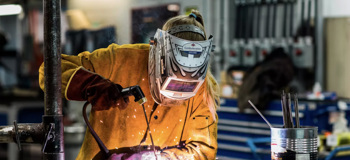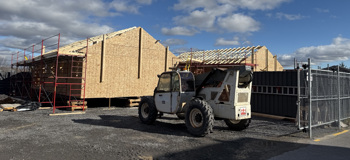
Discover
How Lambton College Supports Welding Students

Source: Nikki Noble
Sarnia’s Lambton College is one of many institutions in Ontario tackling the challenge of training more skilled tradespeople for the provincial workforce.
Nikki Noble is the Program Coordinator of Welding for Lambton’s School of Applied Science, Engineering, Technology, and Trades. She's an entrepreneur, Red Seal welder, fabricator, and 23-year veteran of the trades.
We sat down to talk about Lambton’s Welding program and how it’s structured to support local trades.
Lambton College’s Community Take on Welding
Nikki started at Lambton in 2017 teaching an eight-week apprenticeship program. Lambton was so impressed with how she connected with students, they asked her to sign on as a permanent part-time professor. It wasn’t long before her teaching skills and her passion for welding earned her a full-time position. Only two years after she taught that eight-week course, she was made Program Coordinator of Welding.
At the time, Lambton was thinking about running a two-year Welding Technology program, but there was a problem: most people weren’t coming back to finish their second year.
It didn’t take much digging to understand why: students were going out on work placements and being hired!
“Most of the work around here is unionized,” said Nikki of Sarnia, Lambton’s home.
“So, when these students get a job offer, they know they’ll have a stable, well-paying career – and the companies will train them on the job, so it’s a good deal for them.”
Because of this unique situation, Nikki wanted to see Lambton take a slightly different route.
“My goal is that this will be the best one-year Welding Techniques program in Canada.” So, she set out to make sure that every student in her program left with the essential skills to either gain employment, continue their apprenticeships, or earn their certification.
What Students Learn
Students in this program learn:
- GTAW (also known as TIG): Tungsten inert gas welding is the welding process most commonly used for pipe and pipeline welding, a skill that could be used locally on the Lake Huron pipeline, which is up for replacement. TIG welding is also popular in aerospace and aviation.
- Semi-automatic welding (also known as MIG): Metal inert gas (MIG) welding is faster than TIG and has the added benefit of being able to weld different metals easily. It’s a popular welding type in the automotive industry, construction, manufacturing, railroad construction, and shipping. This type of welding is used in production shops and is a common entry position for new grads.
- Arc welding (Also known as SMAW): Shielded metal arc welding, or simply arc welding comes in many different forms, but the common factor is that it uses electricity to fuse metals. This type of weld is used in heavy equipment repair, shipbuilding, construction, and – with extra training – underwater welding.
Nikki also focuses on other welding and cutting processes that could be useful to students in their future careers. Ultimately, Nikki wants to give her students a taste of the different types of welding while explaining how to problem-solve in the field. She also wants students to understand why it’s important to follow the established process and not take shortcuts.
Preparing Students for Welding Careers
Perhaps most importantly, Nikki hopes to prepare her students for the wide variety of in-demand trades careers around Sarnia, such as:
- Welder / Welder-Fitter
- Boilermaker
- Pressure System Welder
- Industrial Mechanic/Millwright
- Pipe fitter / Steam fitter
- Robotic Welder Operator
Students can also challenge the Level I Welder apprenticeship test after the completion of their program, giving them the opportunity to get a head start on an apprenticeship. Tradespeople looking to take on an apprentice appreciate anyone who comes into the trade with an understanding of the tools and protocols.
This one year program focuses on welding in many forms, which allows students to dive deep into the welding trade, local employer requirements, and prepares them to enter the workforce – all in 28 weeks. Once they’ve completed the program, they can choose from a variety of different pathways.
If you’re interested in Lambton’s Welding program or any other skilled trades opportunities, check out our program search.





